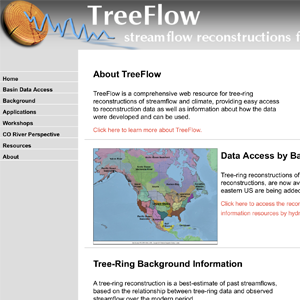Selected research papers, reports, and other resources which show the current state-of-knowledge and the progress in our understanding of the variability of climate and hydrology in the Colorado River Basin and the potential impacts of future climate change.
Paleoclimatic (Tree-ring) Reconstructions
TreeFlow
The TreeFlow web resource developed and maintained by WWA and CLIMAS provides tree-ring reconstructions of annual streamflow for over 60 gages across the U.S., over 30 of which are within Colorado, Utah, and Wyoming. It also has links to tree-ring reconstructions of precipitation, drought indices, and snowpack.
Long-Term Surface-Water Supply and Streamflow Trends in the Upper Colorado River Basin Based on Tree-Ring Analysis (1976) by C.W. Stockton and G.C. Jacoby. The first "modern" tree-ring reconstructions of streamflow in the Upper Colorado River Basin, while superseded by later work, is still a landmark in our understanding of the hydrologic history of the basin.
Observed (Post-1900) Climate and Hydrology
Drivers of Drought in the Upper Colorado River Basin
Website for project by WWA affiliate Connie Woodhouse and others with links to presentations, data and analysis tools, and technical report (2016). Also covers paleoclimate records and future projections for the basin.
Colorado River Basin Water Management: Evaluating and Adjusting to Hydroclimatic Variability, (Executive Summary) The National Academies Press, February 2007
Full Report Available through the National Academies Press
Precipitation History of the Colorado Plateau Region, 1900-2000 (2002). Fact Sheet published by the USGS.
Future Projections of Streamflow and Climate
Colorado River Basin Climate and Hydrology: State of the Science (2020)
WWA Climate Change in Colorado Report (2014) - Section 5-3 discusses projected hydrologic changes in the Colorado River Basin.
